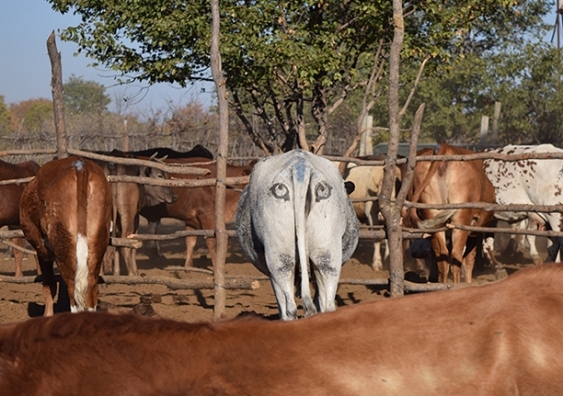Painting eyes on the rumps of livestock can protect them from attacks by lions in landscapes where they co-exist.
That is according to a joint study undertaken by UNSW Sydney, Taronga Conservation Society Australia and Botswana Predator Conservation.
Information about the Eye-Cow Project was recently published in a paper in the journal, Communications Biology.
What did researchers do?
Researchers painted eyes on the backsides of a select number of cattle in the Okavango delta region in Botswana where livestock rub shoulders with lions, leopards, spotted hyaenas, cheetahs and African wild dogs.
They painted one-third of each herd with an artificial eyespot design on the rump, one-third with simple cross-marks and left the rest of the herd unmarked.
They theorised that because predators rely on being undetected by their prey for a successful attack, they could perhaps trick lions into thinking they had lost this advantage and ultimately to give up on the hunt.
“Lions are ambush predators that rely on stalking, and therefore the element of surprise, so being seen by their prey can lead to them abandoning the hunt,” said joint UNSW Science and Taronga Western Plains Zoo researcher Dr. Neil Jordan.
“We tested whether we could hack into this response to reduce livestock losses, potentially protecting lions and livelihoods at the same time.”
UNSW PhD student, Cameron Radford, worked with farmers in the Okavango delta region to paint cattle in 14 herds that had recently suffered lion attacks.
What did they discover?
Researchers found that cattle painted with artificial eyespots were significantly more likely to survive than unpainted or cross-painted control cattle within the same herd.
In fact, no painted ‘eye-cows’ at all were killed by ambush predators during the four-year study, while 15 unpainted and 4 cross-painted cattle were killed, the paper adds.
“While these results do support our initial hunch that creating the perception that the predator had been seen by the prey would lead it to abandon the hunt – the detection hypothesis – there were also some surprises,” Dr. Jordan added.
“Cattle marked with simple crosses were significantly more likely to survive than were un-marked cattle from the same herd.”
Eye-marked cattle more likely to survive
Although eye-marked cattle were more likely to survive than the other groups, this general ‘conspicuousness’ effect, researchers added, suggests that novel cross-marks were better than no marks at all, which was unexpected.
From a theoretical perspective, these results interested the researchers, as no mammals are known to have natural eye-shaped patterns that deter predation.
“To our knowledge, our research is the first-time eyespots have been shown to deter large mammalian predators,” Cameron Radford said.
“Previous work on mammal responses to eye patterns has generally supported the detection hypothesis.”
“We think this may suggest the presence of an inherent response to eyes that could be exploited to modify behaviour in practical situations – such as to prevent human-wildlife conflicts, and reduce criminal activity in humans.”
In addition to the science, the researchers have also produced practical guides to the ‘eye-cow’ technique in both English and Setswana.
They are hopeful that farmers will take up this simple tool, but stressed that it is important for potential users to understand the potential limitations in its use, and choose for themselves.
“The eye-cow technique is one of a number of tools that can prevent carnivore-livestock conflict – no single tool is likely to be a silver bullet.”
“Indeed, we need to do much better than a silver bullet if we are to ensure the successful coexistence of livestock and large carnivores.
“But we’re hoping this simple, low-cost, non-lethal approach could reduce the costs of coexistence for those farmers bearing the brunt,” Dr. Jordan concluded.
Image source: Bex Yexley via UNSW Sydney Website





